Abstract
OBJECTIVE--To evaluate the effectiveness and safety of endometrial laser ablation and transcervical resection of the endometrium compared with hysterectomy in the surgical treatment of women with dysfunctional uterine bleeding. DESIGN--Prospective randomised controlled trial. SETTING--Gynaecology department of a large teaching hospital. SUBJECTS--204 women who would otherwise have been undergoing hysterectomy for menorrhagia were recruited between August 1990 and March 1992 and randomly allocated to hysterectomy (n = 99) or conservative (hysteroscopic) surgery (transcervical resection (n = 52) and laser ablation (n = 53)). MAIN OUTCOME MEASURES--Operative complications, postoperative recovery, relief of menstrual and other symptoms, patient satisfaction with treatment after six and 12 months. RESULTS--Women treated by hysteroscopic surgery had less early morbidity and a significantly shorter recovery period than those treated by hysterectomy (median time to full recovery 2-4 weeks v 2-3 months, P < 0.001). Twelve months later 17 women in the hysteroscopy group had had a hysterectomy, 11 for continuing symptoms; 11 women had had a repeat hysteroscopic procedure; 45 were amenorrhoeic or had only a brown discharge; and 35 had light periods. Dysmenorrhoea and premenstrual symptoms improved in most women in both groups. After 12 months 89% (79/89) in the hysterectomy group and 78% (75/96) in the hysteroscopy group were very satisfied with the effect of surgery (P < 0.05); 95% (85/89) and 90% (86/96) thought that there had been an acceptable improvement in symptoms, and 72% (64/89) and 71% (68/96) would recommend the same operation to others. CONCLUSIONS--Hysteroscopic endometrial ablation was superior to hysterectomy in terms of operative complications and postoperative recovery. Satisfaction after hysterectomy was significantly higher, but between 70% and 90% of the women were satisfied with the outcome of hysteroscopic surgery. Hysteroscopic surgery can be recommended as an alternative to hysterectomy for dysfunctional uterine bleeding.
Full text
PDF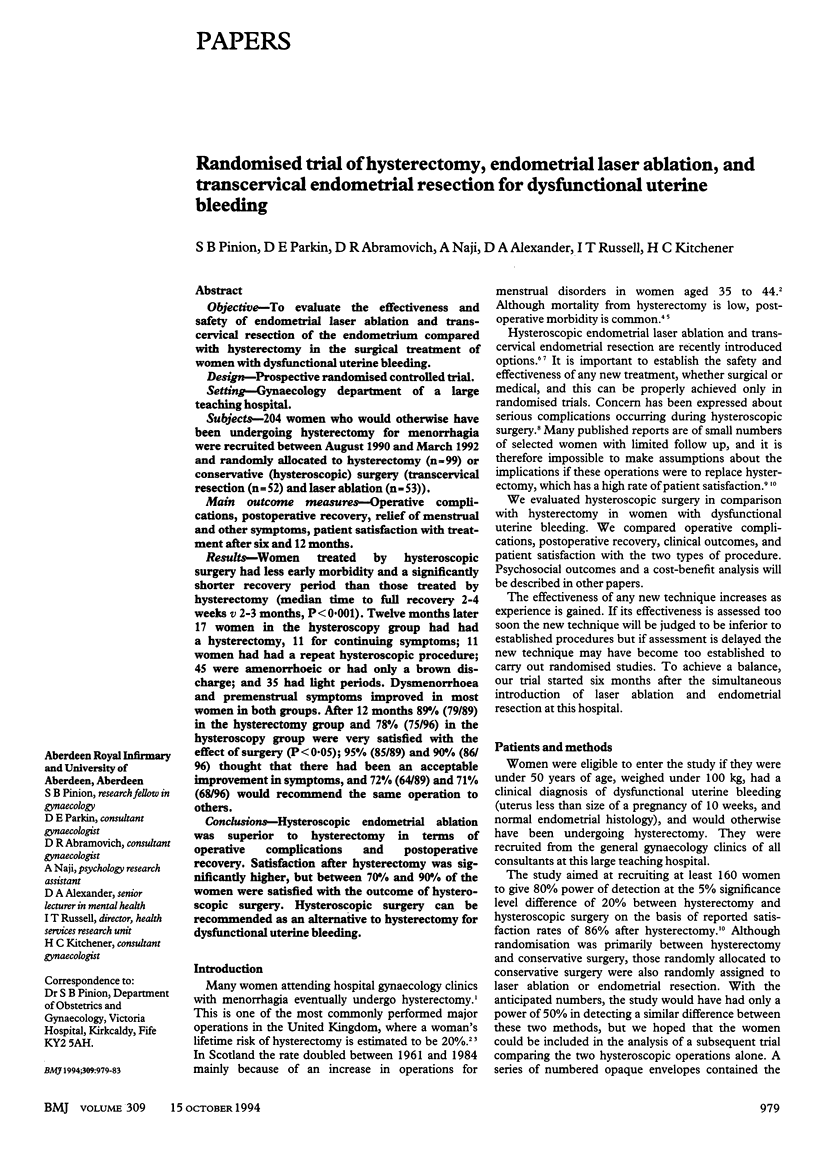
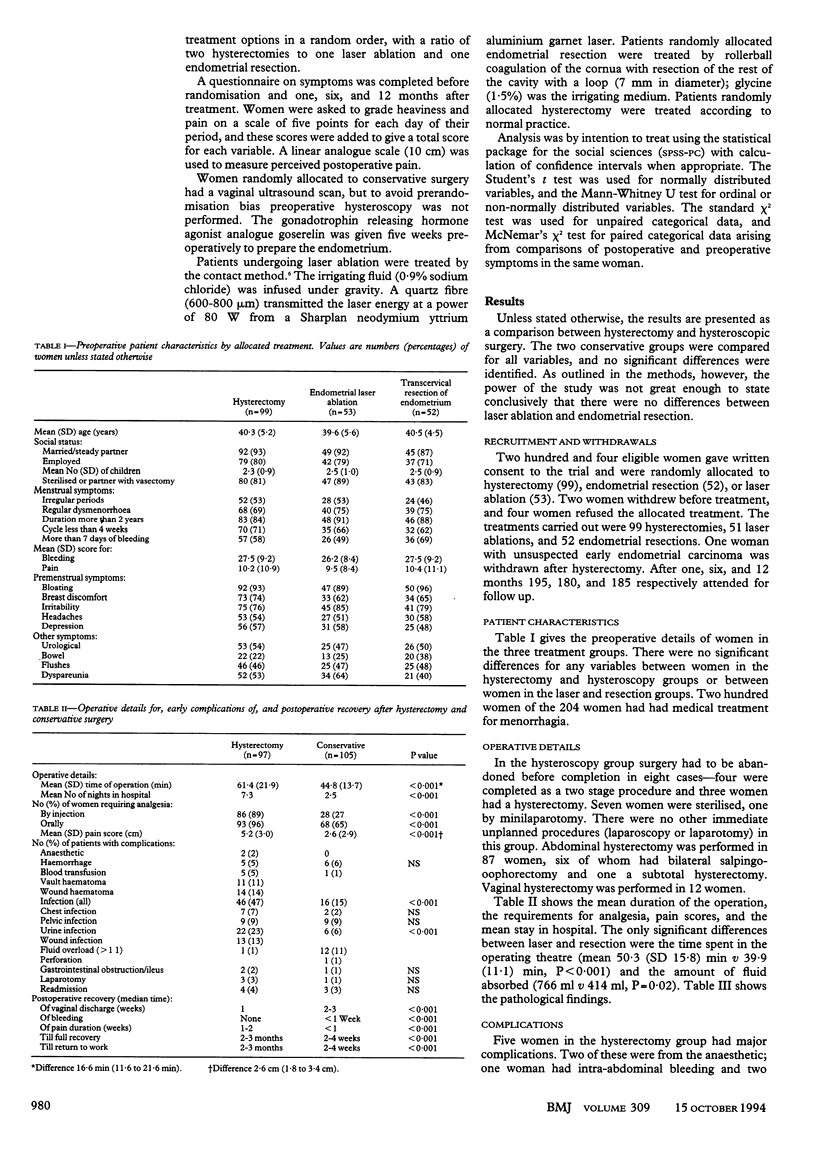
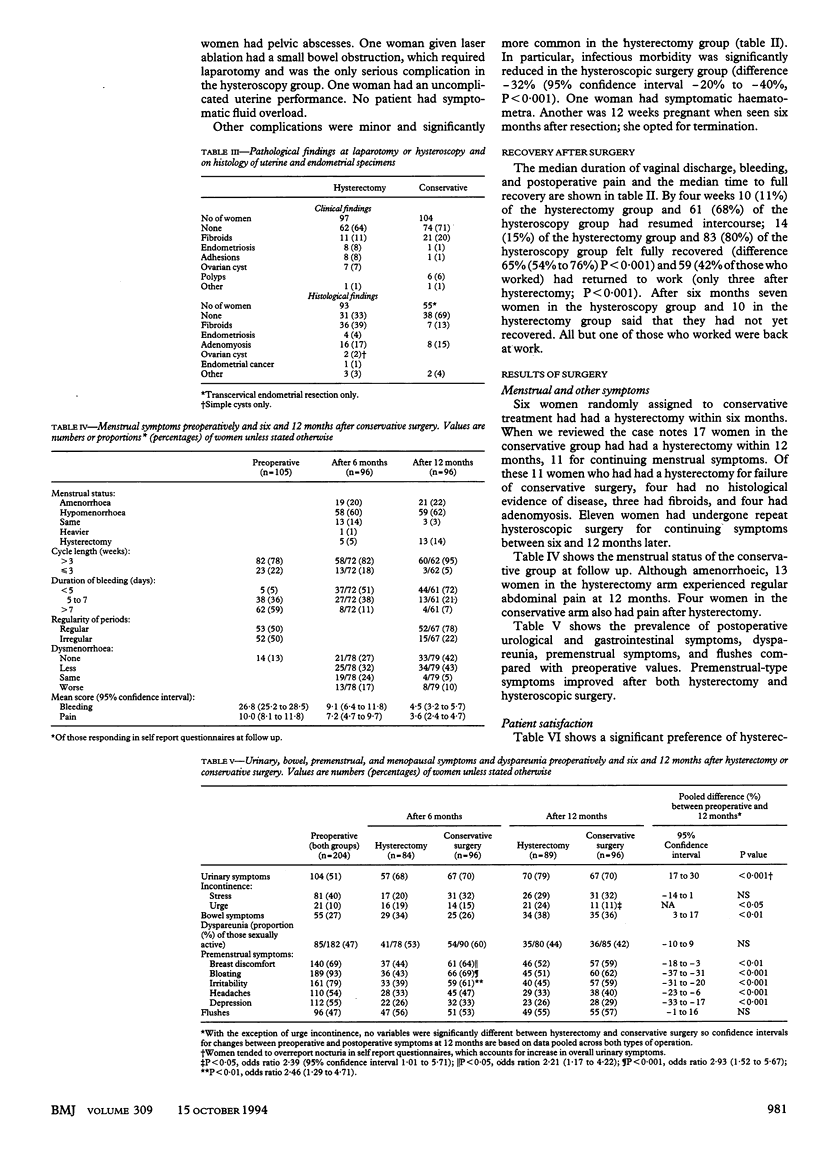
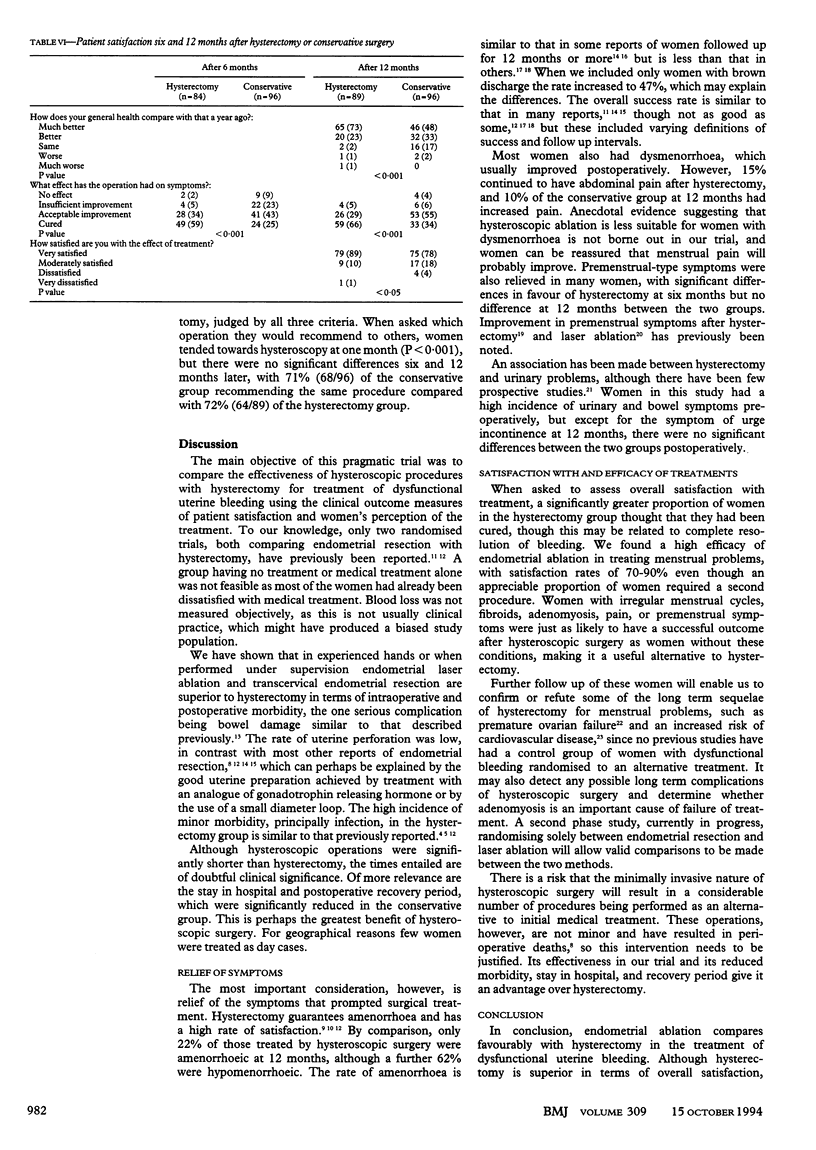
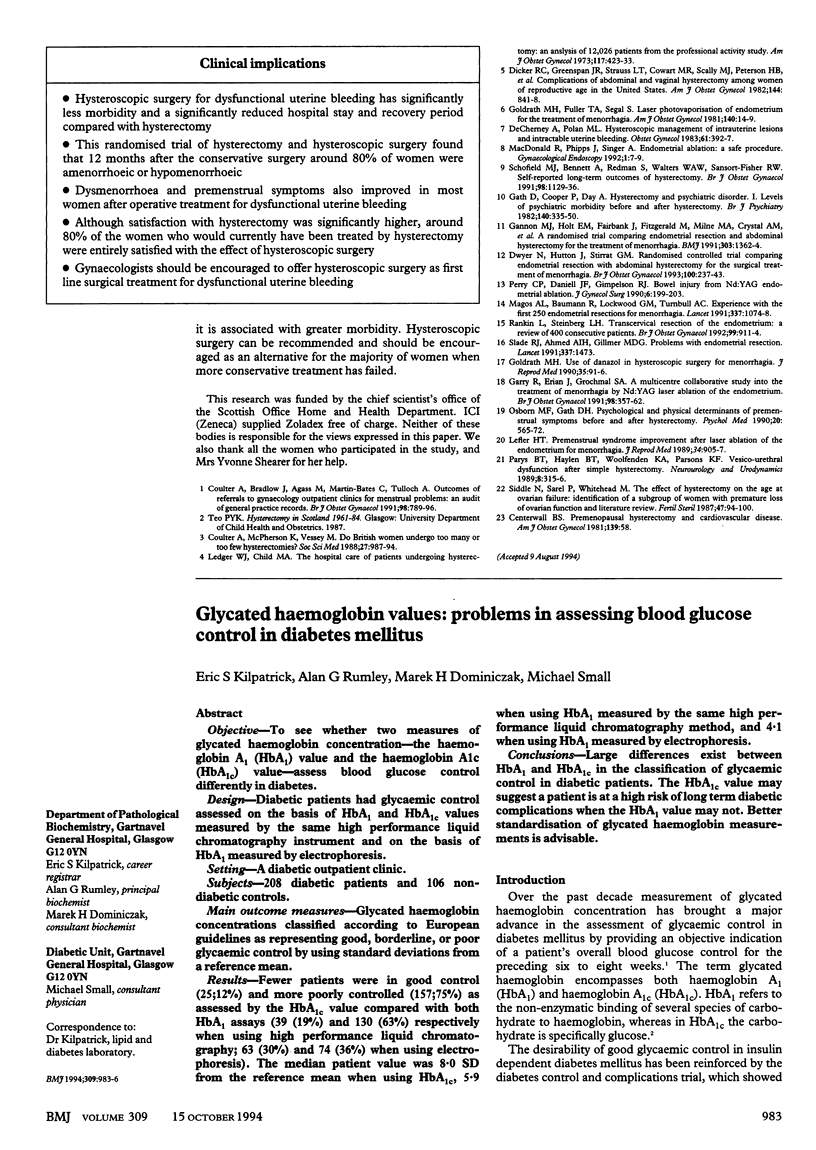
Selected References
These references are in PubMed. This may not be the complete list of references from this article.
- Centerwall B. S. Premenopausal hysterectomy and cardiovascular disease. Am J Obstet Gynecol. 1981 Jan;139(1):58–61. doi: 10.1016/0002-9378(81)90412-9. [DOI] [PubMed] [Google Scholar]
- Coulter A., Bradlow J., Agass M., Martin-Bates C., Tulloch A. Outcomes of referrals to gynaecology outpatient clinics for menstrual problems: an audit of general practice records. Br J Obstet Gynaecol. 1991 Aug;98(8):789–796. doi: 10.1111/j.1471-0528.1991.tb13484.x. [DOI] [PubMed] [Google Scholar]
- Coulter A., McPherson K., Vessey M. Do British women undergo too many or too few hysterectomies? Soc Sci Med. 1988;27(9):987–994. doi: 10.1016/0277-9536(88)90289-4. [DOI] [PubMed] [Google Scholar]
- DeCherney A., Polan M. L. Hysteroscopic management of intrauterine lesions and intractable uterine bleeding. Obstet Gynecol. 1983 Mar;61(3):392–397. [PubMed] [Google Scholar]
- Dicker R. C., Greenspan J. R., Strauss L. T., Cowart M. R., Scally M. J., Peterson H. B., DeStefano F., Rubin G. L., Ory H. W. Complications of abdominal and vaginal hysterectomy among women of reproductive age in the United States. The Collaborative Review of Sterilization. Am J Obstet Gynecol. 1982 Dec 1;144(7):841–848. doi: 10.1016/0002-9378(82)90362-3. [DOI] [PubMed] [Google Scholar]
- Dwyer N., Hutton J., Stirrat G. M. Randomised controlled trial comparing endometrial resection with abdominal hysterectomy for the surgical treatment of menorrhagia. Br J Obstet Gynaecol. 1993 Mar;100(3):237–243. doi: 10.1111/j.1471-0528.1993.tb15237.x. [DOI] [PubMed] [Google Scholar]
- Gannon M. J., Holt E. M., Fairbank J., Fitzgerald M., Milne M. A., Crystal A. M., Greenhalf J. O. A randomised trial comparing endometrial resection and abdominal hysterectomy for the treatment of menorrhagia. BMJ. 1991 Nov 30;303(6814):1362–1364. doi: 10.1136/bmj.303.6814.1362. [DOI] [PMC free article] [PubMed] [Google Scholar]
- Garry R., Erian J., Grochmal S. A. A multi-centre collaborative study into the treatment of menorrhagia by Nd-YAG laser ablation of the endometrium. Br J Obstet Gynaecol. 1991 Apr;98(4):357–362. doi: 10.1111/j.1471-0528.1991.tb13425.x. [DOI] [PubMed] [Google Scholar]
- Gath D., Cooper P., Day A. Hysterectomy and psychiatric disorder: I. Levels of psychiatric morbidity before and after hysterectomy. Br J Psychiatry. 1982 Apr;140:335–342. doi: 10.1192/bjp.140.4.335. [DOI] [PubMed] [Google Scholar]
- Goldrath M. H., Fuller T. A., Segal S. Laser photovaporization of endometrium for the treatment of menorrhagia. Am J Obstet Gynecol. 1981 May 1;140(1):14–19. doi: 10.1016/0002-9378(81)90251-9. [DOI] [PubMed] [Google Scholar]
- Hofmeyr G. J. External cephalic version at term: how high are the stakes? Br J Obstet Gynaecol. 1991 Jan;98(1):1–3. doi: 10.1111/j.1471-0528.1991.tb10300.x. [DOI] [PubMed] [Google Scholar]
- Ledger W. J., Child M. A. The hospital care of patients undergoing hysterectomy: an analysis of 12,026 patients from the Professional Activity Study. Am J Obstet Gynecol. 1973 Oct 1;117(3):423–433. doi: 10.1016/0002-9378(73)90051-3. [DOI] [PubMed] [Google Scholar]
- Lefler H. T., Jr Premenstrual syndrome improvement after laser ablation of the endometrium for menorrhagia. J Reprod Med. 1989 Nov;34(11):905–906. [PubMed] [Google Scholar]
- Magos A. L., Baumann R., Lockwood G. M., Turnbull A. C. Experience with the first 250 endometrial resections for menorrhagia. Lancet. 1991 May 4;337(8749):1074–1078. doi: 10.1016/0140-6736(91)91718-a. [DOI] [PubMed] [Google Scholar]
- Osborn M. F., Gath D. H. Psychological and physical determinants of premenstrual symptoms before and after hysterectomy. Psychol Med. 1990 Aug;20(3):565–572. doi: 10.1017/s0033291700017062. [DOI] [PubMed] [Google Scholar]
- Problems with endometrial resection. Lancet. 1991 Jun 15;337(8755):1473–1474. [PubMed] [Google Scholar]
- Siddle N., Sarrel P., Whitehead M. The effect of hysterectomy on the age at ovarian failure: identification of a subgroup of women with premature loss of ovarian function and literature review. Fertil Steril. 1987 Jan;47(1):94–100. doi: 10.1016/s0015-0282(16)49942-5. [DOI] [PubMed] [Google Scholar]


